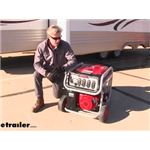A-iPower 9,000-Watt Portable Generator - 7,000 Running Watts - Gas - Electric Start

- All Info
- Q & A (0)
- Photos
A-iPower Generators - 289-SUA9000E
- 9000 Starting Watts
- No Inverter
- Gas
- 12 Volt Output
- 120 Volt Output
- 240 Volt Output
- Electric Start
- Wheels
- A-iPower
- 7000 Running Watts
- Not CARB Approved
Conventional generator supplies power for heavy-duty equipment or emergency situations. Keeps high-draw appliances running during a power outage. Runs up to 8.5 hours on a half load. Simple, push button electric start.
Features:
- 9,000-Watt generator provides a portable power source
- Electric-start engine offers easy, push button startup
- Recoil handle lets you pull start the engine if needed
- 4-stroke engine uses standard unleaded gas - no need to mix gas and oil
- Digital hour meter helps you keep track of how long the generator is running
- Warning lights, voltage regulator, and spark arrestor promote accident-free use
- Fold-down handle and 9" flat-free wheels provide easy mobility
- Strong, tubular steel frame
- Clean-running engine meets EPA standards
Specs:
- Outlets:
- (4) 120V 20-amp GFCI
- (1) 120V 30-amp L5-30R
- (1) 120/240V 30-amp L14-30R
- (1) 12V 8.3-amp DC
- Starting (surge) power output: 9,000 watts
- Running (rated) power output: 7,000 watts
- Continuous run time:
- At rated load: 4-3/4 hours
- At 1/2 load: 8 hours
- Noise level (normal conversation is 60 dB):
- Measured at 23' away: 76 dB
- Engine type: 420-cc, single cylinder, air-cooled, 4-stroke OHV
- Horsepower: 14
- Fuel type: gasoline
- Capacity: 7 gal
- Oil type: SAE 10W-30
- Capacity: 1.2 qt
- Power line frequency: 60 Hz
- Dry weight: 211 lbs
- Dimensions: 27-1/2" long x 26" wide x 26" tall
- Warranty:
- 2-Year limited warranty for residential use
- 1-Year limited for commercial use
Includes:
- Battery
- Wheel kit
- DC charging cable
- Spark plug socket
- Engine oil
Notes:
- This generator is not legal for sale or use in the state of California.
- Gas generators produce carbon monoxide, which is poisonous. For your safety, always be sure to operate this gas-powered generator outdoors.
- Because this generator does not have a built-in inverter to control the electrical current, the voltage can fluctuate. Therefore, do not plug sensitive electronic devices such as a computer or television into the generator.
Certifications
Meets the following important certification standards:
- US Environmental Protection Agency (EPA)
High-Output Capacity

The A-iPower SUA9000E generator produces 9,000 watts of power to get you up and running whether you're at the campsite, at the worksite, or faced with an emergency. This powerful generator comes with (4) 120V GFCI protected outlets for powering household items such as refrigerators, televisions, fans, lights, and tools. It features (1) 120V 30R L5-30R twist-lock outlet for large appliances and motorized tools with greater electrical demands. It has (1) 120/240V 30A L14-30R twist-lock outlet that provides a connection point for an inlet box used in home backup power. Lastly, it includes (1) 12V DC 8.3-amp outlet. This port allows you to use the included DC charging cable to provide a trickle charge to any 12V DC battery. This outlet can also accommodate a USB adapter plug (sold separately) to charge gear that uses a USB cord. The generator also has outlet covers to help keep out moisture and debris.
Easy Electric Start Engine
The generator's engine starts up easily at the push of a button. Simply turn the fuel valve to "on" and flip the engine switch to the "run" position. Then, push the battery power restore switch for a few seconds and release. Once you press the start button, the generator will turn on.
Before starting your generator, ensure nothing is connected to the outlets. Start your generator and let the engine run for a few minutes to warm up and stabilize. Once the generator is up and running, follow the recommended order of operation: connect the device with the highest starting watts first, like your air conditioner or refrigerator, then work your way down to the device with the lowest starting watts. By connecting devices in this order, you'll ensure the generator has enough power to start high-wattage loads.
Safety Features
This generator comes with a number of safety features to protect you, the environment, and the generator itself. When the generator is low on oil, a light-up indicator flashes and the engine will automatically shut down to prevent damage. If an overload is detected, either by exceeding the generator's limits or a power surge, the circuit breaker will stop supplying power to the connected devices. The digital voltage regulator assists in minimizing voltage fluctuations which helps to maintain a steady flow of electricity. Also, a built-in spark arrestor helps prevent any sparking that might burn someone or start a fire.
Choosing a Generator
When choosing a generator, you need to match the generator's starting and running output with the electrical demands of the equipment you want to operate.
Power Demands
Starting (surge) wattage is the power a device requires at startup. Running (rated) wattage is the power needed to keep the device running. A large appliance with an electric motor such as a furnace, refrigerator, air conditioner, or washing machine may require 2 to 3 times more starting wattage than running wattage.
It is always best to start your generator with no load connected, then add each device one at a time. Additionally, a good practice to consider is connecting your devices in order from highest starting watts to lowest starting watts. As you connect and start devices, your available wattage decreases. This order of operation allows you to start devices with the highest power demands when there is more power available.
Will This Generator Run My RV Air Conditioner?
At etrailer, we perform numerous tests on generators that put them through real-world experience. An extensive part of this testing includes starting and running RV air conditioners. The following table will help you decide if the e3200 inverter generator has enough power to handle this critical function in your RV.
| Air Conditioner | Will it start and run? |
|---|---|
| Single 13,500 Btu | Yes |
| Single 15,000 Btu | Yes |
| Dual 15,000 Btu | Yes |
Running Watts and Starting Watts of Common Appliances
| Appliance | Running Watts | Starting Watts |
|---|---|---|
| Air compressor (1/2 hp) | 1,000 | 2,000 |
| Air conditioner (15,000 Btu) | 1,600 | * |
| Air conditioner (13,500 Btu) | 1,300 | * |
| Air conditioner (10,000 Btu) | 1,000 | * |
| Blender | 400 | 850 |
| Cell phone charger | 11 | 0 |
| Clock radio | 4 | 0 |
| Coffee maker (high setting) | 1,066 | 0 |
| Crock pot (low setting) | 126 | 0 |
| Crock pot (high setting) | 374 | 0 |
| Desktop computer | 150 - 350 | 0 |
| DVD player | 14 | 0 |
| Electric drill (3/8" / 4 amps) | 450 | 600 |
| Electric space heater (high setting) | 1,450 | 0 |
| Floor fan | 100 | 0 |
| Hair dryer (low setting) | 160 | 0 |
| Hair dryer (high setting) | 1,300 | 0 |
| LCD television (32") | 68 | 0 |
| Microwave | 1,000 | 0 |
| Refrigerator | 800 | 1,600 |
| Washing machine | 1,150 | 2,250 |
| Work light (quartz halogen) | 1,000 | 0 |
* The starting wattage on air conditioners can vary greatly depending on several factors, including the assistance of built-in capacitors and cold starts. Because of this, we can't list a standard starting wattage as every application can be different.
Determining Your Power Needs
The following section provides calculations for wattage estimates. This will give you an overall picture of your potential power usage and help you decide on the generator that is right for you.
Industry Standard Calculation
The Industry Standard Calculation is a quick and easy way to determine your required wattage. It may provide some padding in your wattage requirements, which could give you more power than you actually need, but you shouldn't have to worry about not having enough power. The following steps will help you quickly calculate the correct size generator to meet your application.
As stated earlier, you should always start your generator without any load, and then connect each device one at a time. The following calculation requires this approach to work. However, using this calculation removes the worry of connecting devices in a certain order.
1. Determine the starting watts and running watts for the devices that you want to plug into the generator.
a. Find the starting (surge) watts and running (rated) watts for each device that you want to plug into the generator. Look for a sticker or plate on each device or check your owner's manuals.
b. If your device or manual only shows amps and volts, watts can also be determined through a simple formula. (Amps x Volts = Watts)
c. List all of your starting watts and running watts as seen in Table 1 below.
Table 1
| Example Devices | Starting Watts | Running Watts |
|---|---|---|
| Air compressor | 2,000 | 1,000 |
| Refrigerator | 1,600 | 800 |
| Microwave | 0 | 1,000 |
| Blender | 850 | 400 |
2. To find the total starting watts required, add the starting watts for the device with the highest value to the running watts of all the other devices from Table 1.
2,000 + 800 + 1,000 + 400 = 4,200 total starting watts
3. To find the total running watts, add all of the running watts together from Table 1.
1,000 + 800 + 1,000 + 400 = 3,200 total running watts
To run all of these devices simultaneously, you would require a generator with at least 4,200 starting watts and 3,200 running watts.
Advanced, Precise Calculation
While the method for calculating your power needs outlined above will work, it isn't the most precise. If you aren't afraid of doing a little more math, you can use the Advanced, Precise Calculation to get a more accurate idea of how much power you will need and potentially save yourself some money. Because the calculation above pads in enough power to ensure you can start your devices in any order, it may point you to a bigger and more expensive generator than you need. However, by following the more regimented, order-of-operations calculation below, you'll get a much more precise idea of how much power you need, which could in turn point you to a smaller and less expensive generator.
Again, you should always start your generator without any load, and then connect each device one at a time. The following calculation also requires that you start your devices in order from highest starting watts to lowest starting watts. When you connect devices in this order, you can start high demand devices when there is more power available.
1. Determine the starting watts and running watts for each device that you want to plug into the generator.
a. Find the starting (surge) watts and running (rated) watts for each device that you want to plug into the generator. Look for a sticker or plate on each device or check your owner's manuals.
b. If your device or manual only shows amps and volts, watts can also be determined through a simple formula. (Amps x Volts = Watts)
c. List out these devices from highest starting watts to lowest starting watts as seen in Table 2 below.
Table 2
| Example Devices | Starting Watts | Running Watts |
|---|---|---|
| Air compressor | 2,000 | 1,000 |
| Refrigerator | 1,600 | 800 |
| Microwave | 0 | 1,000 |
| Blender | 850 | 400 |
2. To find the total running watts, add all of the running watts together from Table 2.
1,000 + 800 + 1,000 + 400 = 3,200 total running watts
3. In Table 3, shown below, the values from Table 2 are used to calculate the highest total starting watts required as devices are connected and running. This number represents the highest power requirement you will encounter as you connect all of your devices to the generator. To find this, add the starting watts of each new device you connect to the combined running watts of all connected devices. The highest of these numbers will be the total starting watts required. And again, remember to always connect devices in order from highest starting watts to lowest starting watts.
Table 3
| Device | Starting Watts | Running Watts of All Connected Devices | Total Starting Watts Required |
|---|---|---|---|
| 1. Air compressor | 2,000 + | 0 (nothing connected) | = 2,000 |
| 2. Refrigerator | 1,600 + | 1,000 (air compressor) | = 2,600 |
| 3. Microwave | 1,000* + | 1,800 (air compressor + refrigerator) | = 2,800 |
| 4. Blender | 850 + | 2,800 (air compressor + refrigerator + microwave) | = 3,650 |
* Even though the microwave does not have starting watts listed, you have to account for the power needed to actually run it.
850 + 2,800 = 3,650 highest total starting watts required
In order to run all of these devices simultaneously, you would require a generator with at least 3,650 starting watts and 3,200 running watts.
SUA9000E AI Power Generator with Wheel Kit - 9,000 Watts 120 Volts - Portable - Gas
Installation DetailsCalifornia residents: click here
See what our Experts say about this A-iPower Generators
- Generator Size Needed to Run Two 15,000 Btu Ducted Atwood Air Command ACs With Heat StripThat is a good question, and when it comes to generators, what we need to look at is the wattage as opposed to amps, and the 15,000 Btu Ducted Atwood Air Command Rooftop RV Air Conditioner with Heat Pump AT15033-22 requires 4,830 starting watts before dropping to 1,530 running watts. So what that means is a 4,000 watt generator won't allow you to run two of these, or add one on in addition to your 13,500 Btu Atwood as there just won't be enough juice. What you would need to do is upgrade...
view full answer... - Weight of A-iPower 9,000-Watt Portable Generator # 289-SUA9000EThe A-iPower 9,000-Watt Portable Generator # 289-SUA9000E that you referenced weighs 210 lbs.
view full answer... - Recommended Portable Generator for RV with Dual AC UnitsBecause of the starting amperage and running amps required for your dual A/C system, I recommend the A-iPower 9,000-Watt Portable Generator - 7,000 Running Watts - Gas - Electric Start # 289-SUA9000E. This will allow for plenty of running power for both units simultaneously but you will of course still need to start one unit at a time. This generator will supply enough power so that it won't dictate which unit the 15k or the 13.5K unit is started first. The starting amps required are...
view full answer... - BTU, Amperage, and Wattage for Atwood 15k BTU AC Unit Plus Generator RecommendationbTu is a measurement of thermal energy. The Atwood Air Command Rooftop RV Air Conditioner w/ Heat Pump # AT15028-22 can put out 15,000 bTu. But if you are interested in the amount of current it draws it's amperage rating is 13.3 amps and wattage is 4,830 watts starting and 1,530 running. So you'd need a generator rated for over 4,830 to run the AC unit. For that the A-iPower 9,000-Watt Portable Generator # 289-SUA9000E would work well and would give you plenty of wattage to run other things...
view full answer... - Could Solar Panels Power RV AC UnitAir conditioners draw way too much amperage for use off of a solar panel. You'd need monstrous solar panels for that which wouldn't be possible in a trailer setup. For mobile power of an AC unit your best option is a generator like the part # 289-SUA9000E as a battery is going to be drained quickly from the higher draw of AC units.
view full answer... - 2003 Ford E450 Shuttle Bus Trailer Hitch and Cargo Carrier Recommendation for GeneratorFor your 2003 Ford E-450 Shuttle Bus, I recommend the Curt Adjustable Trailer Hitch Receiver # C13701. This is rated for 500 lbs tongue weight, which will allow you to safely carry a generator similar to the A-iPower 9,000-Watt Portable Generator # 289-SUA9000E which is 27-1/2" long x 26" wide x 26" tall on a cargo carrier like # FHG69ZR and still have a little extra storage space and weight capacity with the generator weighing 210 lbs dry weight. If you already have a generator, let...
view full answer... - Quieter Generator Availability with Higher Wattage RatingsThe quietest option we have that meets your watt needs is the # 289-SUA9000E by A-iPower which has wattage of 9,000 peak and 7,000 running. It's louder than the Honda you mentioned as it wil 76 db at 23 feet away and the Honda is around 60. Normal conversation level is right at 60.
view full answer...
Do you have a question about this Generator?
Info for this part was:








At etrailer.com we provide the best information available about the products we sell. We take the quality of our information seriously so that you can get the right part the first time. Let us know if anything is missing or if you have any questions.





















































Thank you! Your comment has been submitted successfully. You should be able to view your question/comment here within a few days.
Error submitting comment. Please try again momentarily.